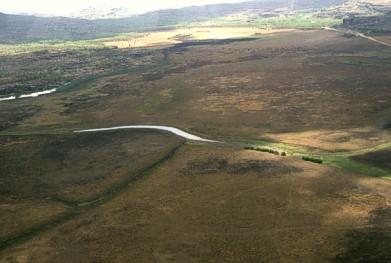Flying across Kakadu National Park
|
Home
Top End
Crossing Capricorn vol. 2
Australia's most central pub
Road trains
Aliens on the road
Devil's Marbles
Desert Rose
Mataranka
Edith Falls
Katherine gorge
Shooting roos
Crocodiles
Gunlom Waterhole
Yellow Waters
Lotos flowers
Fire No. X
Flying across Kakadu
Nourlangie Rock
Paintings on the rocks
Ubirr Rock
General Marsupials Birds More animals Trees Hotels |

Kakadu (named after the Gagudju people living there) is a land of extremes. When we were there in the middle of November it was the end of the dry season and the land was REALLY dry. But within a couple of weeks the wet season would begin again and some more weeks later all that dry land was covered with water lilies growing in deep water. 
There are two rivers crossing the park: the South Alligator River and the East Alligator River, both named by people not knowing the difference between crocodiles and alligators. At this time of the year even the rivers are pretty dry, but the land around them is less dry and still a bit green. 
Absolutely dry here, just sand: the South Alligator river surrounded by Paperbark trees. 
Along the escarpement there is the East Alligator River with still a bit more water in it. The airplane pilot said one may see the salties (Saltwater crocodiles) from aloft, but I haven't seen a single one. There are some rocks along the eastern part of Kakadu, but once they become a plateau they make a different park, Arnhemland.  The National Park is a wonderful piece of untamed nature - with one exception. There is an Uranium mine in the park, making up a shrill disharmony. The Aboriginal owners fought it as good as they could, but in fact the mine was there before the park was founded. So it remained and kept working. But soon the problem will solve itself: Within some 10 years everything worth mining will be mined and the area becomes part of the park. Must be an interesting thing to watch the renaturalisation.  |
Tasmania and NSW -
Tasmania Vol. 2 -
Queensland -
Red Centre -
Top End -
Victoria -
home -
more travel
marsupials - birds - more animals - trees - hotels - at the end - more links - email
marsupials - birds - more animals - trees - hotels - at the end - more links - email
by IKO